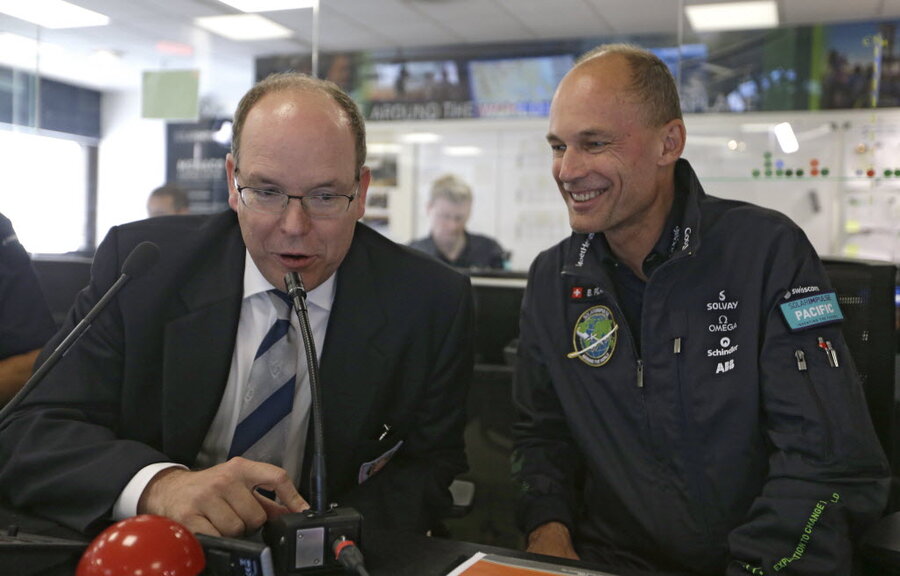Solar Impulse grounded: Can commercial flight go solar?
Loading...
The Solar Impulse 2, a solar-powered plane that set out to be the first aircraft to circle the world without burning fossil fuels, is now grounded in Hawaii for the remainder of the year.
The plane, manned by Swiss pilot Andre Borschberg, successfully completed a trip from Japan to Hawaii earlier this month, landing near Honolulu after a five day and five night journey. Thus far, the Solar Impulse 2 and its crew successfully beat the 76-hour world duration record for a nonstop, solo flight, which was previously set in 2006, and set new duration and distance records for solar-powered flight. Nevertheless, the plane will be unable to complete the remainder of its planned journey until April or May 2016 due to battery damage.
Members of the Solar Impulse team noted that flight managers had miscalculated the temperature increases the aircraft would experience during a journey through tropical climates, and the appropriate quantity of insulation required for such a journey. The damage is "not a technical failure or weakness in the technology,” they stressed in a statement. But regardless of the setback’s causes, the team’s successes and failures have left many speculators wondering whether the solar energy business will eventually make its way into the mainstream aviation industry.
“For commercial purposes, the Solar Impulse 2 obviously isn't very useful as is. It can only carry two people and travels at top speeds of just 43 miles per hour. By contrast, a Boeing 747-400 can carry more than 400 people and travel at top speeds of 570 miles per hour,” Brad Plumer wrote for Vox.
“So unless there's some truly radical advance in solar-cell technology, we're unlikely to see solar-powered aircraft that can carry many passengers or heavy cargo in the foreseeable future,” he concluded.
Moreover, adverse weather conditions can cause setbacks for solar-powered planes that other aircrafts don’t have to face, observers point out.
“Cloud coverage is one of the biggest risks: if the plane can’t draw enough power from its solar cells to fly the plane and recharge the batteries to fly at night, it’s game over for the pilot, so a meteorological team has to keep an eye on the surrounding weather,” wrote Chris Mills for Gizmodo, as he covered the extensive ground crew needed to ensure that Solar Impulse 2 completes its flights safely.
“Even then, the plane’s slow top speed means that a stiff headwind can completely ruin the mission, something that’s already caused problems for the team,” he added.
Nevertheless, the traditional aviation industry is coming under increased scrutiny as research reveals that emissions from aviation are the fastest growing source of anthropogenic greenhouse gas. Many environmental activists and academics now say that people should stop flying entirely unless the aviation industry can radically alter the way it operates. On Monday, climate change activists entered the runway at Heathrow airport in London and chained themselves to a tripod in protest over a proposed third runway. Flights were delayed as a result.
Environmental activists haven't had much negative impact thus far on the aviation industry’s business – airline revenue has doubled over the past decade from US$369 billion in 2004 to a around $746 billion in 2014 – but increased concern over the issue is motivating companies to search for more sustainable modes of operation.
American Airlines, for example, has pledged to improve its carbon efficiency by 30 percent between 2005 and 2025 as part of its Fuel Smart Initiative. To reduce jet fuel use, the company now uses more Ground Power Units for electricity when it is parked, and uses computer-determined optimal flying speeds for fuel efficiency when it’s in the air.
Delta, meanwhile, managed to reduce its carbon emissions by 25 percent between 2000 and 2006 by installing winglets on its aircrafts that promote fuel savings.
Still, further efforts will be needed if air travel is to become truly sustainable. Solar-powered fuel cells and biofuels are other environmentally friendly ideas that have been tossed around. Nevertheless, it would be a huge step forward to create a zero carbon emission commercial aircraft, and the Solar Impulse 2 could provide an example of how this sort of technology could be used in the future.
Meanwhile, some inspired inventors are optimistic that technology will advance quickly enough to make these environmentally friendly flights a reality in coming years.
In April, Spanish designer and aviation enthusiast Oscar Vinals presented the design of the AWWA-QG Progress Eagle, which he envisioned as a triple-decker aircraft with no carbon emissions.
"Today we have about 40 percent of the technology needed to build it," Mr. Vinals told CNN.
"Quantum solar cells, nanowires to kinetic power, micro radio wave harvesters -- these technologies only exist in a limited scale at the best laboratories around the world. But in a few years, we could overcome our limits and build anything imaginable,” he concluded confidently.
Currently, the Solar Impulse 2 has 17,000 solar cells mounted on its 236-foot wings. The aircraft also counts on four lithium-polymer batteries that store energy during the day to power the aircraft during the night.
The Solar Impulse 1 succeeded in crossing the United States in 2013.






